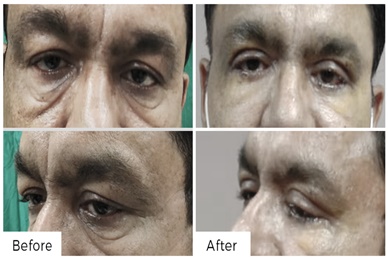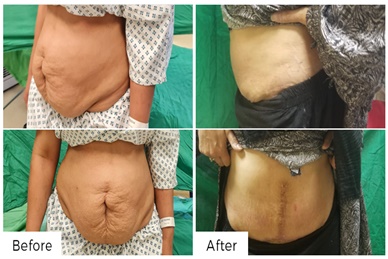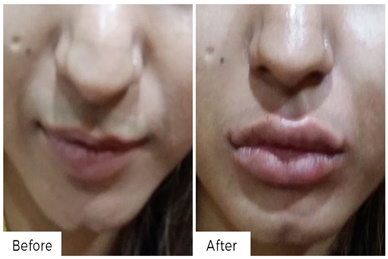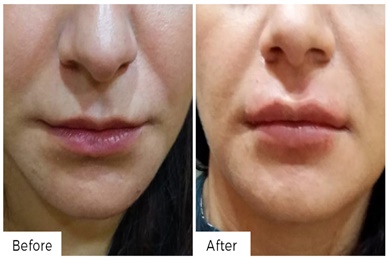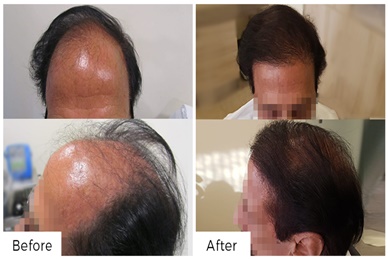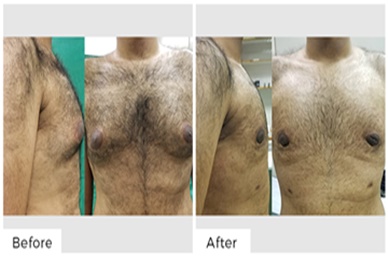The procedures, techniques, and principles of cosmetic surgery are entirely focused on enhancing a patient’s appearance and beauty, while the functional restoration of the particular part of the body is also taken care of. Cosmetic surgery helps the patient achieving his desired looks and also restore physical characteristics effected by aging, or accident, or any other traumatic factor. Improving aesthetic appeal, symmetry, and proportion are the key goals.
An aesthetic or cosmetic surgery can be performed on all parts of a human body.
- Hair Transplantation
- PRP
- Medicatiasis
- Rhinoplasty (nose reshaping)
- Chin or Cheek Enhancement
- Rhytidectomy (Facelift)
- Neck lift
- Brow lift
- Fat grafting
- Blepharoplasty (eyelid lift)
- Otoplasty (ear correction)
- Thread lift
- Lip enhancement and reduction
- Facial wrinkles
- Sagging skin of face
- Breast Augmentation
- Mastopexy (Breast Lift)
- Breast Reduction
- Gynaecomastia correction (enlarged breasts in men)
- Nipple reduction
- Areola reduction
- Inverted nipples
- Brachioplasty (Upper arm lift)
- Thighplasty (Thigh lift)
- Rejuvenation of hands and feet
- Abdominoplasty (Tummy Tuck)
- Liposuction (Removal of fat)
- Lower body lift
- Butt augmentation /reduction
- Post bariatric procedures
- Belt lipectomy
- Skin Resurfacing
- Botox
- Filler Treatments
- PRP
- Nano fat grafting
Giving someone their desired looks is an art that requires several years of training and experience but many untrained doctors and even non-doctors claim their expertise. It is advised to check credentials of your doctor and where that doctor is going to operate. Small private clinics and small hospitals are never safe.
A discussion of all potential benefits and complications should be held during consultation with a cosmetic surgeon.
Services
Aesthetic Surgery Procedures
A large amount of effort and money is spent on hair grooming in order to recapture a youthful appearance. Considering its significance, it is easy to understand why hair loss is such a concern and why people seek hair transplantation.
The latest form of hair transplant has revolutionized the approach of restoration of hair of the head, beard, moustache and eyebrows whether the cause of hair loss is natural or by scars.
Two main procedures are commonly done:
- Follicular Unit Transplantation (FUT): Hair from back are surgically taken in form of a strip, each hair is then manually taken out, reimplanted to where required.
- Follicular Unit Extraction (FUE): No surgical procedure is required, hair roots are extracted by a punch and reimplanted. No cuts are given.
In both procedures, hair from back of the head are taken and transferred to the front where required. Reason for this that the hair from the back are not affected by male hormones, hence do not fall before and after transplant.
The roots are then placed in a pre-selected area after determining the right direction of hair in that area. Once the procedure is complete, hair will grow normally and no extra care will be required. They can be cut normally, they will grow normally, can be even shaved and will grow again. They can be dyed and permed or whatever can be done to natural hair.
Totally painless procedure in relaxed and friendly environment but still within the protected hospital environment with all safety measures readily available on site.
Procedure Highlights:
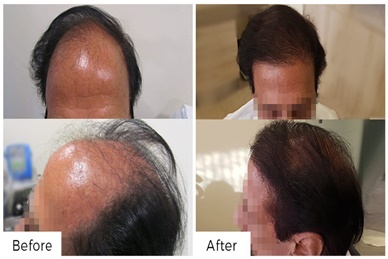
- 5-6 hour surgery with general anaesthesia
- Day care procedure
- Advised no exertion or exercise for 10 days
- Special way for hair wash for first 10 days
- No smoking for 10 days
Plastic surgery on the nose, commonly known as a nose job is a cosmetic procedure that is performed to enhance the appearance of the nose and also to improve breathing. In this surgery, an experienced plastic surgeon will sculpt the cartilages and bone of the nose and also add cartilage and bone from other areas into nose if needed. In case of accidental nasal deformity, plastic surgeon might need to involve other specialties like maxillofacial and ENT to give best possible care to patient.
Procedure Highlights:
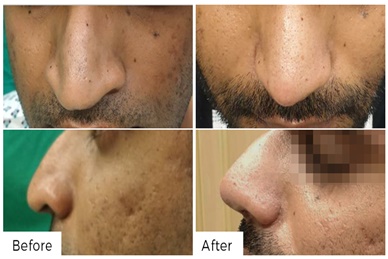
- 2-3 hour surgery with general anaesthesia
- One day hospital stay
- If nose packing is done, they are removed on the 2nd day
- Stitches are removed in 6-7 days
- The cast on the nose is removed or changed on the 10th day
- Patient should stay in the city for 10 days for post-operative follow ups
- There may be edema in the face and nose with some bruises for 2 weeks
- The results will be visible straightaway but will get better over the next few months
Upper eyelids begin to loosen up and create skin folds drooping over the eyelashes or may become puffy while lower eyelids develop puffiness and then become more troublesome with descend of the midface as the age advances. Eyelid surgery can transform the appearance of the individual. It is a pretty simple operation that can be done under local anaesthesia and also on outpatient basis. This procedure has very few complications and scarring is barely visible.
Procedure Highlights:
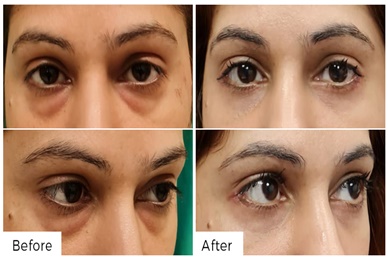
- 1-2 hour surgery
- Local anaesthesia (with sedation if required)
- Same day hospital discharge
- Stitches are removed on the 6th day
- Patient should stay in the city for 10 days for post-operative follow ups
- There will be slight edema and some bruising for 2 weeks maximum
- The results will be final in 6 weeks
- The scar is in the lid fold so it is not visible
The face loosens and sags down after 40 years of age or even earlier in some cases. The facelift procedure is not a single operation, but the name of a group of surgical techniques that tighten up and redrapes the face to more youthful appearance. The technique is chosen according to the patient’s needs. Procedures required in facial rejuvenation are fat grafting, facelift, MACS lift, thread lift, blepharoplasty, neck lift etc. For over the 50s a full facelift is required with incisions (cuts) passing in front of the ears, as the jaw and neck have to be addressed.
Procedure Highlights:

- 5-6 hour surgery with general anaesthesia
- 1-2 days hospital stay
- Smoking should be avoided 2 weeks prior to surgery
- Some drugs may need to be stopped for a week before surgery
- Stitches are removed in 5-7 days
- Patient should stay in the city for 10 days for post-operative follow ups
- There will be some edema and bruises for 2 weeks
- The results will settle in 6 weeks
Abdominoplasty operation or tummy tuck surgery is the removal of excess fat and skin of the abdomen which is usually gained after weight gain and pregnancy. Abdominal muscles may also need to be tightened in order to achieve desired shape.
Procedure Highlights:
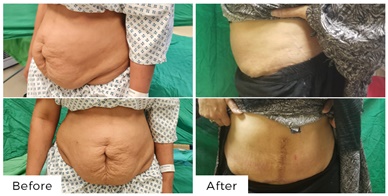
- 3-4 hour surgery
- General anaesthesia
- One day hospital stay
- Usually, stiches are removed in stages
- Patient should stay in the city for 10 -15 days for post-operative follow ups
- A special corset should be used for 4 weeks
- Results will settle in 12 weeks
Liposuction is the most commonly performed cosmetic surgery procedure requiring general/local anaesthesia that is effective to remove fat from areas like thighs, abdomen, arms and back. It could be a day care procedure or may require admission depending on area to be addressed. This technique uses a small hole through which a tube sucks out fat.
Procedure Highlights:
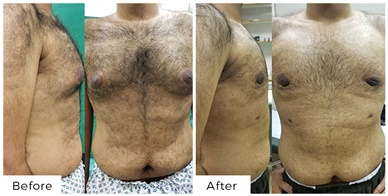
- Approximately 1-5 hour surgery
- Local or general anaesthesia
- One day hospital stay
- Bruises & edema may last for a few weeks
- Patient should stay in the city for 10 days for post-operative follow ups
- A special corset should be worn for 4 weeks
- Results will settle in 2-3 months
Due to aging ,facial skin droops and some muscles start to function more in order to compensate this droop, ending up in lines and folds in skin. Botox is used to weaken their effect in order to achieve smoother wrinkle free skin. Usually Botox is used for forehead creases, angry lines above nose, corner of mouth lines and also folds in neck. Botox can also be used by our experts to lift eyebrows for a more aesthetic look.
Procedure Highlights:
- 15-minute intervention
- No anaesthesia is required
- Can be performed on an outpatient basis
- The patient may return home on the same day
- May need to visit in 4-6 days for touchups
- Should be repeated every 4 to 6 months
- The effect will start on the third day and settle on 7th day
Filler is a very simple and very effective way to fill up wrinkles and rejuvenate skin even in young individuals and also to fill up unevenness of skin. It is a very common, satisfying and an absolutely harmless procedure without side effects. Filler can be synthetic or can be one’s own fat. If it is synthetic then it will be a clinic procedure. In case of Micro fat, it will be a day care procedure.
Procedure Highlights:

- For Synthetic filler:
- 15-minute intervention in OPD
- No anaesthesia is required
- Can be performed on an outpatient basis
- The patient may return home on the same day
- May need to visit in 4-6 days for touchups
- Should be repeated every 8 to 10 months
- Change will be visible straight away
- For Micro fat:
- Local anaesthesia is required
- Day care procedure
- Patient goes home the same day
- May need to be repeated after 1 year
- Permanent effect after 3 months
This is a condition in which there is male breast development, which is in most young individuals a physiological process but very embarrassing for the young males. Sometimes there is fat but more commonly it has glandular tissue also. Removal of fat and gland is done in operating theatre, mostly under anaesthesia. This surgery is very rewarding with excellent outcome.
Procedure Highlights:

- One day stay in the hospital
- Four weeks of pressure garment on the chest
- Normal physical activity after 4 weeks
- Return to job in a few days
- No long term care is required
Frequently Asked Questions
Cosmetic surgery is performed to reshape normal structures of the body in order to improve appearance and self-esteem, while reconstructive surgery is performed on abnormal structures of the body caused by congenital defects, developmental abnormalities, trauma, infection, tumors or disease. In general, reconstructive surgery is performed to improve or restore function.
Most reconstructive surgeries are performed on an in-patient basis, especially in case of emergency surgeries. While most cosmetic surgeries are elective and can be done in our dedicated cosmetic operation theatre on day care basis. Some more extensive cosmetic surgeries like Rhinoplasty, Abdominoplasty etc. will require in-patient care postoperatively.
Soft Tissue Fillers are very effective in smoothing out and filling in bothersome wrinkles and lines, particularly in the lower part of the face. Most commonly available fillers we used are Hyaluronic Acid (HLA). It has several advantages over other filler-type materials such as collagen; it lasts longer and causes very little adverse reaction. It is easy to administer (injected through a small needle), and once its effectiveness has diminished six months to a year later, the body safely absorbs it.
Soft Tissue Fillers (HLA) and Botox (botulinum toxin) often are used in a complementary fashion. While Soft Tissue Fillers are best for the lower face, Botox is great for wrinkles that occur in the upper face – crow's feet or the vertical frown lines between the eyebrows – because it paralyzes muscle and nerve endings, stopping the skin from wrinkling.
Botox lasts about four to six months, and the treatment can be repeated as needed. When it wears off, you will begin to notice increased muscle action and some reformation of the wrinkles. It appears that with repeated use, the effect of Botox becomes longer lasting. Soft tissue Fillers injections last for about six months, and can also be repeated as needed.
The decision is based on a number of factors, including the patient's desires, overall health and reasons for the surgery like you feel your breasts are too small relative to your body contour or are you unhappy with the size and firmness of your breasts following pregnancy, breastfeeding or major weight loss.
Your surgeon can help you make the right decision during your pre-surgical appointment.
Very few patients notice small change in their voice after rhinoplasty but this is uncommon. Professionals who rely on their voice, such as singers, should share any concerns with their surgeon
Breathing difficulty through nose is a common reason why patients seek rhinoplasty, your surgeon will correct the deformed walls of your inner nose and opens the airway for better passage of air during breathing.
Patient in their late 40’s generally have loose skin on face especially in their jowls and neck. These patients will get best results with face and neck lifts. Minimal skin excess can be addressed with thread lifts as well. Your surgeon needs to examine you before deciding which procedure is best for you.
During pre-procedural visits, your surgeon will ask you to do a few blood tests to access your general health. For procedure to be performed in general anaesthesia, some more tests might be required.
Yes, tumescent liposuction, a technique that results in less bruising, less bleeding, less swelling and a quicker recovery than older traditional methods of liposuction, is routinely performed in Liaquat National Hospital.
Yes. Depending upon what the procedure is, it might make sense to sleep in a reclining (not horizontal) position for one week following surgery, to minimize the collection of fluids in the face and eyelids.
Follow the instructions you will be given about making and administering your cold and warm compresses. These will not only reduce bruising and swelling, but they will also maximize and promote healing.
There are risks associated with any surgical procedures but as Liaquat National Hospital is a tertiary care centre, we have a well-equipped setup to handle any possible complications
Before surgery, also consult your doctor and find out which complications are possible, how often they occur and how they will be handled if they do occur. If the doctor advices otherwise, seek another opinion.
The cause of male pattern baldness is no more a mystery. Research has shown that various hormones and enzymes in men can cause permanent baldness. The hormones cause hair follicles to shrink and grow at an increasingly slower rate until hair growth ceases completely. Genetics, hormones and age largely dictate the pattern and extent of progression and speed of baldness.
Follicular unit micro-grafting, unlike other techniques, requires separation of hair follicles under magnification which are then inserted in a particular manner into the skin. Sometimes as many as 1200-2000 such grafts need to be inserted at the same sitting. The whole procedure needs an extreme degree of dexterity, skill, training and above all patience. We feel that all the above virtues were instilled in us during our training to become plastic surgeons.
The discomfort associated with hair restoration surgery is bearable while local anaesthetic is being administered and after that the whole procedure should be painless. The procedure may become somewhat tiring for the patient depending upon how large the area has to be covered.
Hair restoration surgery is performed under local anaesthesia and involves only the outer layer of the body. The side effects are relatively minor consisting of mild pain and discomfort after the operation. There is some swelling at the side of the hair graft, which may move down to the eyes, and the formation of a scab over the graft which may take approximately one week to resolve. Serious problems of bleeding, scarring and infections are rare.
The number of procedures required depends upon the extent of hair loss, the area to be covered and the amount of donor hair you can spare.
Your transplanted hair will require the same sort of treatment as the hair of the rest of your head. Your will be able to color, style and groom it to suite your lifestyle.
Women bald different from men. Usually, it is a generalized thinning. Using the same principles, hair can be grafted from areas which thick hair growth to area where the hair is sparse.
Faculty
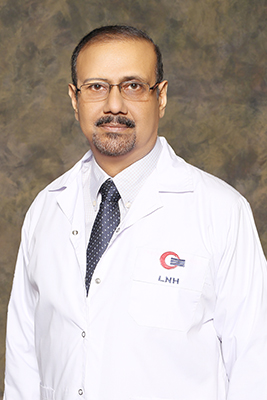
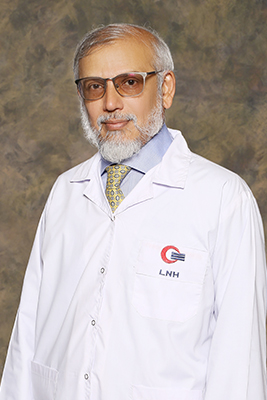
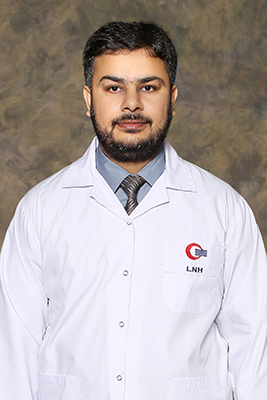
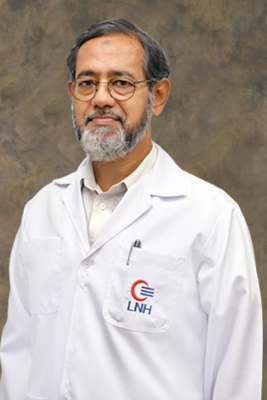

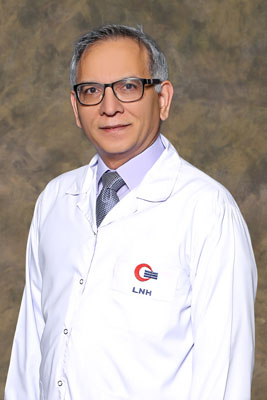
Contact
Please call us on: 021-34412450, 021-34412486 and 0349-7599901 .

